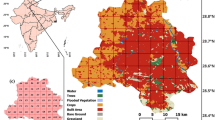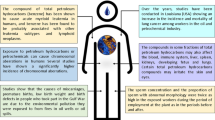Abstract
Male Sprague–Dawley rats were exposed to ethylbenzene (200, 400, 600 and 800 ppm) and to two mixed xylenes (250, 500, 1,000 and 2,000 ppm total compounds) by inhalation, 6 h/day, 6 days/week for 13 weeks and sacrificed for morphological investigation 8 weeks after the end of exposure. Brainstem auditory-evoked responses were used to determine auditory thresholds at different frequencies. Ethylbenzene produced moderate to severe ototoxicity in rats exposed to the four concentrations studied. Increased thresholds were observed at 2, 4, 8 and 16 kHz in rats exposed to 400, 600 and 800 ppm ethylbenzene. Moderate to severe losses of outer hair cells of the organ of Corti occurred in animals exposed to the four concentrations studied. Exposure to both mixed xylenes produced ototoxicity characterized by increased auditory thresholds and losses of outer hair cells. Ototoxicity potentiation caused by ethylbenzene was observed. Depending on the mixed xylene studied and the area of the concentration–response curves taken into account, the concentrations of ethylbenzene in mixed xylenes necessary to cause a given ototoxicity were 1.7–2.8 times less than those of pure ethylbenzene. Given the high ototoxicity of ethylbenzene, the safety margin of less or equal to two (LOAEL/TWA) might be too small to protect workers from the potential risk of ototoxicity. Moreover, the enhanced ototoxicity of ethylbenzene and para-xylene observed in mixed xylenes should encourage the production of mixed xylenes with the lowest possible concentrations of ethylbenzene and para-xylene.








Similar content being viewed by others
References
Agency for Toxic Substances, Disease Registry (ATSDR) (1998) ATSDR evaluation of health effects of chemicals. V. Xylenes: health effects, toxicokinetics, human exposure, and environmental fate. Toxicol Ind Health 14:571–781
American Conference of Governmental Industrial Hygienists (ACGIH) (2002) Documentation of the threshold limit values and biological exposure indices. ACGIH, Cincinnati
Angerer J, Lehnert G (1979) Occupational chronic exposure to organic solvents. VIII. Phenolic compounds—metabolites of alkylbenzenes in man. Simultaneous exposure to ethylbenzene and xylenes. Int Arch Occup Environ Health 43:145–150
Backes WL, Sequeira DJ, Cawley GF, Eyer CS (1993) Relationship between hydrocarbon structure and induction of P450: effects on protein levels and enzyme activities. Xenobiotica 23:1353–1366
Bergeron RM, Desai K, Serron SC, Cawley GF, Eyer CS, Backes WL (1999) Changes in the expression of cytochrome P450s 2B1, 2B2, 2E1, and 2C11 in response to daily aromatic hydrocarbon treatment. Toxicol Appl Pharmacol 157:1–8
Campo P, Lataye R, Cossec B, Placidi V (1997) Toluene-induced hearing loss: a mid-frequency location of the cochlear lesions. Neurotoxicol Teratol 19:129–140
Cappaert NLM, Klis SF, Muijser H, de Groot JCJ, Kulig BM, Smoorenburg G (1999) The ototoxic effects of ethyl benzene in rats. Hear Res 137:91–102
Cappaert NL, Klis SF, Baretta AB, Muijser H, Smoorenburg GF (2000) Ethyl benzene-induced ototoxicity in rats: a dose-dependent mid-frequency hearing loss. J Assoc Res Otolaryngol 1:292–299
Cappaert NL, Klis SFL, Muijser H, Kulig BM, Smoorenburg GF (2001) Simultaneous exposure to ethyl benzene and noise: synergistic effects on outer cells. Hear Res 162:67–79
Cappaert NLM, Klis SFL, Muijser H, Kulig BM, Ravensberg LC, Smoorenburg GF (2002) Differential susceptibility of rats and guinea pigs to the toxic effects of ethyl benzene. Neurotoxicol Teratol 24:503–510
Crofton KM, Lassiter TL, Rebert CS (1994) Solvent-induced ototoxicity in rats: an atypical selective mid-frequency hearing deficit. Hear Res 80:25–30
Dennison JE, Bigelow PL, Mumtaz MM, Andersen ME, Dobrev ID, Yang RS (2005) Evaluation of potential toxicity from co-exposure to three CNS depressants (toluene, ethylbenzene, and xylene) under resting and working conditions using PBPK modeling. J Occup Environ Hyg 2:127–135
European Centre for Ecotoxicology and Toxicology (ECETOC) (1986) Joint assessment of commodity chemicals no 6: xylenes. ECETOC, Brussels, Belgium, pp 1–61
European Centre for Ecotoxicology and Toxicology (ECETOC) (1995) Assessment factors in human health risk assessment. Technical report no. 68. ECETOC, Brussels, Belgium, pp. 1–55
European Centre for Ecotoxicology and Toxicology (ECETOC) (2003) Derivation of assessment factors for human health risk assessment. Technical report no. 86. ECETOC, Brussels, Belgium, pp. 1–86
Ehyai A, Freemon FR (1983) Progressive optic neuropathy and sensorineural hearing loss due to chronic glue sniffing. J Neurol Neurosurg Psychiatry 46:349–351
Elovaara E, Engstrom K, Vainio H (1984) Metabolism and disposition of simultaneously inhaled m-xylene and ethylbenzene in the rat. Toxicol Appl Pharmacol 75:466–478
Engström K, Riihimaki V, Laine A (1984) Urinary disposition of ethylbenzene and m-xylene in man following separate and combined exposure. Int Arch Occup Environ Health 54:355–363
Feron VJ, Woutersen RA, Arts JH, Cassee FR, de Vrijer F, van Bladeren PJ (1995) Safety evaluation of the mixture of chemicals at a specific workplace: theoretical considerations and a suggested two-step procedure. Toxicol Lett 76:47–55
Gagnaire F, Langlais C (2005) Relative ototoxicity of 21 aromatic solvents. Arch Toxicol 79:346–354
Gagnaire F, Marignac B, Langlais C, Bonnet P (2001) Ototoxicity in rats exposed to ortho-, meta- and para-xylene vapours for 13 weeks. Pharmacol Toxicol 89:6–14
Gardner R (1996) A statistical analysis of data on exposure to xylene at selected workplaces in the UK. Ann Occup Hyg 40:411–422
Gonzalez-Reche LM, Schettgen T, Angerer J (2003) New approaches to the metabolism of xylenes: verification of the formation of phenylmercapturic acid metabolites of xylenes. Arch Toxicol 77:80–85
Imaoka S, Funae Y (1991) Induction of cytochrome P450 isozymes in rat liver by methyl n-alkyl ketones and n-alkylbenzenes. Effects of hydrophobicity of inducers on inducibility of cytochrome P450. Biochem Pharmacol 42(Suppl.):143–150
Jacobson GA, McLean S (2003) Biological monitoring of low level occupational xylene exposure and the role of recent exposure. Ann Occup Hyg 47:331–336
Jang JY, Droz PO, Kim S (2001) Biological monitoring of workers exposed to ethylbenzene and co-exposed to xylene. Int Arch Occup Environ Health 74:31–37
Krämer A, Linnert M Jr, Wrbitzky R, Angerer J (1999) Occupational chronic exposure to organic solvents XVII. Ambient and biological monitoring of workers exposed to xylenes. Int Arch Occup Environ Health 72:52–55
Loquet G, Campo P, Lataye R (1999) Comparison of toluene-induced and styrene-induced hearing losses. Neurotoxicol Teratol 21:689–697
Metrick SA, Brenner RP (1982) Abnormal brainstem auditory evoked potentials in chronic paint sniffers. Ann Neurol 12:553–556
Morata TC, Nylen P, Johnson AC, Dunn DE (1995) Auditory and vestibular functions after single or combined exposure to toluene: a review. Arch Toxicol 69:431–443
Morata TC, Fiorini AC, Fischer FM, Colacioppo S, Wallingford KM, Krieg EF, Dunn DE, Gozzoli L, Padrao MA, Cesar CL (1997) Toluene-induced hearing loss among rotogravure printing workers. Scand J Work Environ Health 23:289–298
Morata TC, Johnson AC, Nylen P, Svensson EB, Cheng J, Krieg EF, Lindblad AC, Ernstgard L, Franks J (2002) Audiometric findings in workers exposed to low levels of styrene and noise. J Occup Environ Med 44:806–814
Morioka I, Kuroda M, Miyashita K, Takeda S (1999) Evaluation of organic solvent ototoxicity by the upper limit of hearing. Arch Environ Health 54:341–346
Muijser H, Hoogendijk EM, Hooisma J (1988) The effects of occupational exposure to styrene on high-frequency hearing thresholds. Toxicology 49:331–340
Müller MJ (1991) Frequency representation in the rat cochlea. Hear Res 51:247–254
Nakajima T (1997) Cytochrome P450 isoforms and the metabolism of volatile hydrocarbons of low relative molecular mass. J Occup Health 39:83–91
Nylen P, Hagman M (1994) Function of the auditory and visual systems, and of peripheral nerve, in rats after long-term combined exposure to n-hexane and methylated benzene derivatives. II. Xylene. Pharmacol Toxicol 74:124–129
Pathiratne A, Puyear RL, Brammer JD (1986) A comparative study of the effects of benzene, toluene, and xylenes on their in vitro metabolism and drug-metabolizing enzymes in rat liver. Toxicol Appl Pharmacol 82:272–280
Periago JF, Prado C (2005) Evolution of occupational exposure to environmental levels of aromatic hydrocarbons in service stations. Ann Occup Hyg 49:233–240
Pryor GT, Rebert CS, Howd RA (1987) Hearing loss in rats caused by inhalation of mixed xylenes and styrene. J Appl Toxicol 7:55–61
Pryor G, Rebert C, Kassay K, Kuiper H, Gordon R (1991) The hearing loss associated with exposure to toluene is not caused by a metabolite. Brain Res Bull 27:109–113
Ruth JH (1986) Odour thresholds and irritation levels of several chemical substances: a review. Am Ind Hyg Assoc J 47:A142–A151
Sams C, Loizou GD, Cocker J, Lennard MS (2004) Metabolism of ethylbenzene by human liver microsomes and recombinant human cytochrome P450s (CYP). Toxicol Lett 147:253–260
Scientific Committee on Occupational Exposure Limits (SCOEL) (1995) Recommendations of the Scientific Committee on occupational exposure limits to chemical agents: ethylbenzene, SCOEL/SUM/28E
Sequeira DJ, Cawley GF, Eyer CS, Backes WL (1994) Temporal changes in P-450 2E1 expression with continued ethylbenzene exposure. Biochim Biophys Acta 1207:179–186
Sliwinska-Kowalska M, Zamyslowska-Szmytke E, Szymczak W, Kotylo P, Fiszer M, Wesolowski W, Pawlaczyk-Luszczynska M (2003) Ototoxic effects of occupational exposure to styrene and co-exposure to styrene and noise. J Occup Environ Med 45:15–24
Sliwinska-Kowalska M, Zamyslowska-Szmytke E, Szymczak W, Kotylo P, Fiszer M, Wesolowski W, Pawlaczyk-Luszczynska M, Bak M, Gajda-Szadkowska A (2004) Effects of coexposure to noise and mixture of organic solvents on hearing in dockyard workers. J Occup Environ Med 46:30–38
SRI International (1994) Directory of chemical producers. Stanford Research Institute, Menlo Park, pp 997–998
Sulkowski WJ, Kowalska S, Matyja W, Guzek W, Wesolowski W, Szymczak W, Kostrzewski P (2002) Effects of occupational exposure to a mixture of solvents on the inner ear: a field study. Int J Occup Med Environ Health 15:247–256
Sullivan MJ, Rarey KE, Conolly RB (1988) Ototoxicity of toluene in rats. Neurotoxicol Teratol 10:525–530
Tardif R, Charest-Tardif G, Brodeur J (1996) Comparison of the influence of binary mixtures versus a ternary mixture of inhaled aromatic hydrocarbons on their blood kinetics in the rat. Arch Toxicol 70:405–413
Tardif R, Charest-Tardif G, Brodeur J, Krishnan K (1997) Physiologically based pharmacokinetic modeling of a ternary mixture of alkyl benzenes in rats and humans. Toxicol Appl Pharmacol 144:120–134
Tassaneeyakul W, Birkett DJ, Edwards JW, Veronese ME, Tassaneeyakul W, Tukey RH, Miners JO (1996) Human cytochrome P450 isoform specificity in the regioselective metabolism of toluene and o-, m- and p-xylene. J Pharmacol Exp Ther 276:101–108
Toftgard R, Nilsen OG (1982) Effects of xylene isomers on cytochrome P-450 and in vitro enzymatic activities in rat liver, kidney and lung. Toxicology 23:197–212
Toftgard R, Halpert J, Gustafsson JA (1983a) Xylene induces a cytochrome P-450 isozyme in rat liver similar to the major isozyme induced by phenobarbital. Mol Pharmacol 23:265–271
Toftgard R, Nilsen OG, Glaumann H, Gustafsson JA (1983b) Induction of cytochrome P-450 in the rat liver after exposure to xylenes, dose–response relationship and dependence on endocrine factors. Toxicology 27:119–137
Wallen M, Holm S, Nordqvist MB (1985) Coexposure to toluene and p-xylene in man: uptake and elimination. Br J Ind Med 42:111–116
World Health Organization (1996) Ethylbenzene. Environmental health criteria 186. World Health Organization, Geneva
World Health Organization (1997) Xylenes. Environmental health criteria 190. World Health Organization, Geneva
Yano BL, Dittenber DA, Albee RR, Mattsson JL (1992) Abnormal auditory brainstem responses and cochlear pathology in rats induced by an exaggerated styrene exposure regimen. Toxicol Pathol 20:1–6
Yuan W, Sequeira DJ, Cawley GF, Eyer CS, Backes WL (1997) Time course for the modulation of hepatic cytochrome P450 after administration of ethylbenzene and its correlation with toluene metabolism. Arch Biochem Biophys 339:55–63
Author information
Authors and Affiliations
Corresponding author
Rights and permissions
About this article
Cite this article
Gagnaire, F., Langlais, C., Grossmann, S. et al. Ototoxicity in rats exposed to ethylbenzene and to two technical xylene vapours for 13 weeks. Arch Toxicol 81, 127–143 (2007). https://doi.org/10.1007/s00204-006-0124-y
Received:
Accepted:
Published:
Issue Date:
DOI: https://doi.org/10.1007/s00204-006-0124-y




